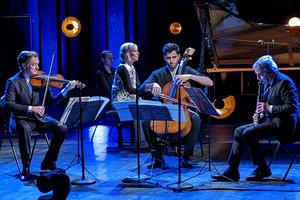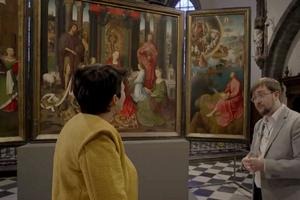A remarkable international chamber musician, the violinist performs and comments Quartet for the End of Time by Olivier Messiaen as part of “Between the Lines”, an ecumenical and cultural magazine launched on Sunday June 26 on France 2. Renaud Capuçon is also invited to “Le Grand Échiquier”, Friday July 1 on France 3.
Fascinating, disturbing and bearer of Hope, the Apocalypse of Saint John written in Greek on Patmos in the 1st century is the New Testament book of Revelation of Christ Victorious. His prophetic visions have fed the imagination of the greatest artists and filmmakers, taking up in their own way the trumpets, the 4 horsemen and their attribute, the opening of the 7 seals and the transfigured Jerusalem…
Listening to the text of the Bible and accompanied by the Dominican brother Pierre de Marolles (photo), the presenter of “Between the lines”, Christelle Ploquin, opens us to the great works that are: the Altarpiece of the two Saints John (The Evangelist and the Baptist, see photo) by Hans Memling in Bruges, engravings from the‘Apocalypse by Albrecht Dürer, the illustrations of the Bible by Gustave Doré (1966), the medieval tapestry of theApocalypse (14th century) at the castle of Angers, Goudji’s goldsmithery with the 12 stones (jasper, sapphire, chalcedony, emerald…) of the celestial Jerusalem or the ten tapestries panels The song of the world of Jean Lurçat, modern vision of the dangers which weigh on humanity with The Man from Hiroshima, The Great Charnel but also The Man in Glory in Peace… For the musical part of the magazine broadcast at 10 a.m. Sunday June 26 on France 2, we find Renaud Capuçon who put Quartet for the End of Time by Olivier Messiaen on the program of the Easter festival in Aix-en-Provence, which he created in 2013 and which will celebrate its tenth anniversary next year.
TV MAGAZINE. – Renaud Capuçon, this new magazine invites us to an understanding “Between the lines”, is this also the case between the staves of music scores?
Renaud CAPUÇON – Music is just that! It is often said that silences speak louder than music. In Quartet for the end of time, the use of silence is essential. It’s very beautiful because there are so many things that you can convey through music but that you couldn’t express in words.
This is particularly true in the work of Olivier Messiaen, which depicts the horror of the Nazi camp while expressing a hope…
Yes, it’s like a cry to Heaven. We have chosen to decentralize the concert to the Camp des Milles Memorial Site, an internment and then deportation camp in the municipality of Aix, to evoke this piece created in 1932 by Olivier Messiaen from a concentration camp in Silesia (Stalag VIII -A in Görlitz). The “Between the Lines” takes on its full meaning since we were both in a transposition of time and place with this very charged death camp thread. But music also carries hope because Messiaen was a very fervent Catholic who put his music at the service of faith. This is assumed and highlighted in all his work. I wanted to share the work with musicians from different backgrounds: Iranian cellist Kian Soltani, Canadian pianist Hélène Mercier and Austrian clarinettist Andreas Ottensamer.
“The relationship to time changes with age. In music, this involves the use of tempo and silence”.
What place does Quartet for the End of Time in your life?
I played it a lot when I was young because it’s a centerpiece of the repertoire, I played it for the festival I organized at home in Chambéry and also because I have faith. It’s interesting to play it at different times in its existence. I don’t know if it’s age, 45, that mathematically makes us closer to the end, but this dramaturgy towards death takes on its full meaning. The relationship to time changes and in music, this effectively involves the particular use of tempo and silence. In the text of the Apocalypse, completely fantastic and frightening, we find many things of our time. It is disturbingly topical, it is a text of great modernity.
“I played ‘Quartet for the End of Time’ a lot because it is a centerpiece of the repertoire and because I have faith”.
So you bear a double responsibility vis-à-vis the composer and the biblical message?
The interpreter must serve the composer with his personality of course, without stepping aside, but without passing above the one who wrote the musical work. In this subtle balance, especially when it comes to a very strong relationship to the sacred as with Johann Sebastian Bach, humility is essential.
What is the role of the violin in End of time quartet and why this use of legato?

The legato is like a thread that stretches and must never be broken even if we change the direction of the bow, we play with great fluidity. The tempo is very slow, the notes suspended. The work is made up of several different pieces and we don’t always play together. There is both a great clarinet solo and two praises cello/piano and violin/piano. The violinist is not more important but he bears a great responsibility because he plays in the very drawn-out last piece which closes the quartet on a high note. This long hold on the violin supports the work like a great bow. It is one of the most exceptional compositions of the 20th century from a spiritual, musical and writing point of view. She is immediately recognizable.
Does practicing chamber music bring a different vision of interpretation?
The first quality of a chamber musician is listening. When I hear soloists who can be great, I know immediately if they played chamber music. In fact, the greatest musicians are all great chamber musicians. When we listen to the other, we are richer in so many things…
You have a contract with Banijay, what is it exactly?
I simply created a production company barely six months ago called Beau Soir Productions (in homage to the song by Claude Debussy and Gabriel Fauré which invites you to taste the charm of being in the world, Ed.) . The vocation of Beau Soir Productions within the framework of the Banijay company is to play on a short scale for young musicians, that is to say to play with them during festivals and major concerts by forming chamber orchestras which mix the generations. We also have recording projects with them. This summer, we will be at the Berlioz festival, in La Roque-d’Anthéron, in Bélaye, at the Nuits du château de la Moutte, ie twenty-five concerts.
“In “Le Grand Échiquier”, I will play surrounded by five young musicians. I trust them, they trust me, the programmer trusts us, it’s a virtuous circle”.
Why not put them in the first part of concerts or consider TV shows?
I don’t really believe in the first parts. The fact of playing with an artist places us as equals, nothing better to progress. It’s not a gimmick. There is no contest, I don’t audition young people, I do it by cooptation, they are only musicians I know. The idea is to make them move faster, to advise them. Everyone has their own way, mine is organic. We will also all be in “Le Grand Échiquier”, Friday July 1 on France 3. I will be playing with five young people around me. It will be the same on the radio or in other broadcasts. For some works I will even be the second violin, at the heart of the whole but highlighting them. I trust them, they trust me, the programmer is confident, it’s like a virtuous circle.
After Movie theater devoted to film music and A violin in Pariswhat will be the theme of your next album?
I will be releasing a record at the end of September with The four Seasons by Vivaldi recorded with my chamber orchestra of Lausanne (Renaud Capuçon is the titular conductor, editor’s note) and two violin concertos by the Chevalier de Saint-George, a wonderful little-known composer and violinist who lived at the time of Mozart ( Joseph Bologne, outstanding fencer, son of a slave of Senegalese origin and an aristocratic planter, was born in 1739 in Guadeloupe, editor’s note).
» Follow all the news from Magazine on Facebook and Twitter .

